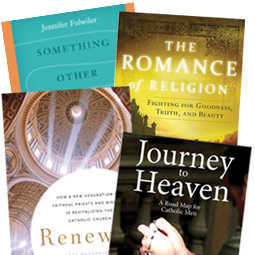Preserving Religious Art
Museum of Divine Statues Showcases Sacred Works

The distinctive cadence of Gregorian chant greets visitors as they enter the yellow brick Museum of Divine Statues in Lakewood, Ohio.
In the dignified ambiance of the decommissioned church, families and tour groups speak softly as they study a treasure trove of approximately 100 statues, stained-glass windows, Stations of the Cross and other works of Catholic art.
"The Eucharist is not present," said museum founder and curator Lou McClung. "This is not a church. But I want a spiritual sense for the museum. The artwork is beautiful, but it’s important for what it represents."
Preserving Treasures
McClung manufactures and distributes cosmetics for a living, but he restores religious statues in his off hours, using original manufacturers’ catalogues as his guide. As his collection grew, he dreamed of establishing a museum devoted to traditional Catholic art.
He was prompted to take action in 2009, when the Diocese of Cleveland began a reconfiguration. Population shifts and fewer priests led to the closing of 50 parishes, many in once-thriving ethnic neighborhoods.
McClung hoped to exhibit art from most of the closed churches, and he managed to acquire quality items from at least 30. He bought the decommissioned St. Hedwig Church in Lakewood, a suburb of Cleveland, because it was structurally sound and needed no expensive repairs. He knew its 3,000 square feet would effectively display the art.
The not-for-profit museum opened in April 2011. McClung dedicated its vestibule to St. Hedwig out of respect for the former parish. Relocated from the sanctuary, a mosaic of the 13th-century saint now makes an immediate impact inside the entrance. As visitors climb stairs leading to the museum proper, they pass a vibrant, illuminated stained-glass window of St. Hedwig that once graced a now-shuttered church.
Inside the museum, visitors come face-to-face with a life-size statue of the Holy Family flanked by freestanding, backlit stained-glass windows. McClung highlighted the images of St. Casimir and Our Lady of Czestochowa by replacing the opaque glass surrounding them with cobalt blue glass.
Beyond this striking partition, statues of St. Lucy, St. Sebastian, St. Francis of Assisi and other holy men and women line the walls.
Some of the statues previously adorned old-fashioned altars or hung high on church walls. In the museum, visitors can admire them close up, noting the detail lavished on facial features and clothing. Each statue is well lit and rests on a custom-built pedestal. A nearby station relates its provenance, composition and a brief biography of the saint.
"Confirmation classes come here because [students] can see three-dimensional representations of their saints and read about them," McClung said.
A Marian shrine dominates much of the midsection of the museum. The upper portion of an elaborate wooden altar provides a splendid backdrop for statues of Our Lady of Mount Carmel, Mother of Grace and Our Lady of Lourdes. Parish groups accompanied by priests often pray the Rosary here.
Walking behind this shrine to Mary, visitors encounter a wall displaying an icon of Our Lady of Perpetual Help, a statue of the Assumption and various depictions of the Virgin Mary. Other Marian statues are positioned in eye-pleasing clusters that invite inspection. Framed by a Gothic arch, each is bathed in a pool of light.
A moving 11-foot-tall Crucifixion tableau occupies a place of honor in the former sanctuary. Carved from a single slab of Botticino marble, its cross and corpus rise above the somber figures of the Blessed Mother and St. John the Evangelist, as well as a kneeling, grief-stricken Mary Magdalene.
Small adjacent chapels hold an imposing array of religious art, including an altar bearing the Pietá, a life-size statue of the Sacred Heart and a replica of Christ’s tomb.
Respecting a Mission
The Museum of Divine Statues is not affiliated with the Diocese of Cleveland, but the diocese recognizes its commitment to preserve and showcase Catholic art. When Cleveland Bishop Richard Lennon reported on the status of decommissioned churches in January 2012, he held his press conference at the museum. The bishop praised its mission and described the site as a "beautiful venue."
The diocese typically sells items from closed churches to other churches around the country, but it has permitted McClung to buy many pieces. The museum founder still has $30,000 in credit-card debt from these purchases, and he is grateful to families and individuals who have sponsored several objects on display. An admission fee helps defray operating expenses.
The diocese lends the museum items from its archives for temporary exhibit, such as an exquisite three-foot-tall monstrance fashioned in solid brass with gold overlay and studded with rhinestones. God the Father appears above the glass casing for the Host, while the base depicts the assumption of Mary.
McClung said the museum is honored to exhibit sacred art once cherished by immigrants who founded the now-closed parishes. "Think of the people who came to this country," McClung said. "They had nothing. But, eventually, they gave what they had to build these churches."
Jerri Donohue writes from Brecksville, Ohio.
Planning Your Visit
The Museum of Divine Statues is located at 12905 Madison Ave., Lakewood, Ohio. It is open Sundays from noon-4pm. Admission is $8. Group tours are given by appointment. For more information, call (216) 228-9950.
- Keywords:
- June 15-28, 2014
















